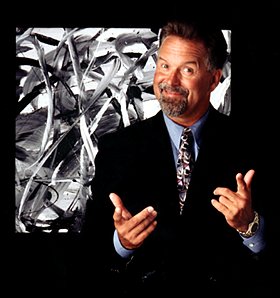|
m

|
__________________________________________________________________________________________________________________________________
(EXCERPTS)
THE PAINTINGS REVEALED
BOLD, ADVENTUROUS, AND SPIRITED SPONTANEOUS USE OF COLOR, SHAPE, AND
LINE.
THERE WERE NO LABORIOUS ATTEMPTS AT TECHNIQUE OR TRADITIONAL IMAGERY.
IT WAS OBVIOUS THAT HE HAD ASSESSED THE MAELSTROM AND LEGACY OF CONTEMPORARY
ART,
LEAPING HEADLONG INTO A PROLIFIC PRODUCTIVITY.
8/95
-RALPH WHITE 1921-2004
PROFESSOR EMERITUS UNIVERSITY OF TEXAS, AUSTIN
In short,
the paintings of Jack Nichols are icons of energy - the energy of the
man himself, and by inference,
the pervasive energy of the universe.
Early on, Nichols - by nature bent, not by some cool rationality, found
himself in the crossroads and gale of abstract expressionism.
He sensed
a resonance with the works of Pollock to Franz Kline, and others of the
New York School
and was moved to find ways to give visual form to his
own aesthetic experience.
The result, to date, has been rich and various - an extensive number of
small and large paintings,
mostly in acrylic of arresting quality. How
to characterize these is no simple task. Still,
there are some things
this writer can risk saying about them:
They reflect the freedom of the
autodidact;
They document the direction of post-modern art;
They exist as statements
of a gifted man finding his ways to exude the energy of his personal
quest…
and they are beautiful records of that quest.
2-22-2004
-Donald L. Weismann 1914-2007
Past Member, National Council For
The Arts
(Appointment by President Johnson)
Now
after
thirty-two years as a contemporary artist, original works only hang in New York,
London,
Rome, Los Angeles,
Washington DC, Houston, South Hamptons, Canada, Denver, Mexico City,
Taos, NM,
and various collections including Dr. Paul Greengard (2000 Nobel Prize
winner in Medicine),
to Ron Brownstein, Dan Balz, Stanley Hirsch , and Ron Rettner collections
in Washington DC & New York.
Since moving to Taos, New Mexico (2007),
it has been a non-stop experience and experiment of channeling the
energies
of nature and sometimes the super-nature. Like a collaboration of the raw and powerful
elements (spirits)
that make up the history of this high-altitude
location.
"The second highest, and longest continuous living location in the
world, second only to Tibet"
To the best of my knowledge, neither Pollock, DeKooning, Rothko, or any artist of the New York
School
ever painted using my / these techniques.
As the methods I've developed over the last thirty two years, did not exist when they were alive.
So... the closer you look the better.
The paintings are not a picture of a thing, they are the thing its
self, not cropped,
left to right, top to bottom, deckled edges,
one hundred percent of the image is what you see.
(the same with
the canvases)
Art is either plagiarism or revolution...
-Paul
Gauguin
French Post-Impressionist
(1848 - 1903)
